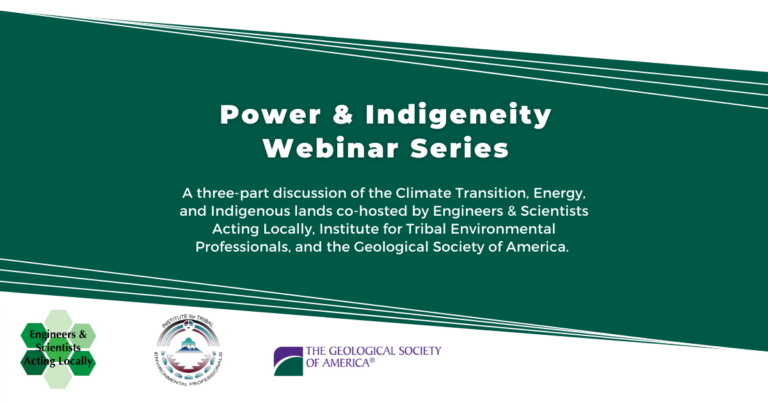
This summer, Engineers and Scientists Acting Locally (ESAL), the Institute for Tribal Environmental Professionals (ITEP), and the Geological Society of America (GSA) co-hosted a three-part panel series titled “Power & Indigeneity,” which explored climate change and the renewable energy transition in the context of Indigenous communities in the United States. Each panel touched on different aspects of this complex topic, while drawing on common themes: sovereignty, historical context, and traditional knowledge. The series highlighted the importance of elevating Indigenous perspectives in the national discussion on climate change.
Part 2: “Land Use, Critical Mineral Mining, and the Fossil Fuel Transition”
This panel featured four scientists with experience around metals or mining. The panel was moderated by Kendra Zamzow, a member of ESAL’s steering committee, and environmental program manager for Chickaloon Native Village (Nay dini’ aa na’ Kayax).
Throughout history, mining has occurred on or near Indigenous lands, with serious and ongoing consequences for the environment and public health. Now, the push toward clean energy is increasing the demand for critical minerals, particularly lithium. The discussion focused on the question: “How can we transition away from fossil fuels in a way that does not make this problem worse?”
Batteries increasingly rely on lithium. Miller outlined the types of lithium deposits, the processes that mining companies use to source lithium, and the environmental impacts of these different processes. Batteries and wind technology rely on rare earth elements, and Stoy described how rare earths and other metals needed in green technologies may be extracted from waste products, such as coal ash or sludge from abandoned mine drainages.
Nuclear power may also be needed to transition away from fossil fuels. Tommy Rock discussed the impacts of past uranium mining on Indigenous communities. There are 524 abandoned uranium mines on Navajo Nation, and over 15,000 abandoned mines across 14 Western states, many on or near tribal lands. For Rock, the issue is personal. His grandfather, a World War II veteran and former uranium miner, died of cancer due to his exposure. Danger still exists even after the mines have closed. “There’s a lack of potable water on Navajo Nation … so people go to these isolated, unregulated waters,” Rock explained. “There’s other places off the reservation that still have abandoned uranium mines that are still open and some of the ore is out in the open as well, so it’s still an ongoing issue.”
As panelists explored the issues posed by critical mineral mining, as well as possible solutions, the same key themes developed in Part 1 of the series were woven throughout the discussion: sovereignty, historical context, and ties to the land.
Sovereignty can be part of the solution to ensure that mining companies adhere to responsible environmental practices. Suter explained that tribal nations can create their own environmental standards on tribal lands that go above and beyond those set by the federal government. The problem comes when mines are not on tribal lands but in the surrounding areas. Here, there needs to be early consultation with tribal communities so that negative outcomes, such as environmental damage or destruction of sacred burial sites, can be mitigated.
Historical context was also discussed. Both Rock and Suter noted the need to clean up past mining activities. “I really advocate that the federal government needs to get their act together and provide some funding associated directly with reclamation of hard rock mines,” Suter said. Stoy’s research raises the possibility that new technologies could be developed to clean abandoned mining sites while simultaneously recovering valuable minerals from the waste. “We need rare earth elements to power our green energy transition. And we have this second problem of these big messes […] that are hazardous to local communities. I’m really intrigued by the idea of tying these problems together so we can clean up these sites with a goal of recovering rare-earths and other valuable minerals […] feeding two birds with one scone.”
Indigenous communities have intense and complex ties to the environment as part of their way of life which, Suter noted, also means that Indigenous peoples are more exposed to environmental hazards than the general population, which she said is something that risk assessments of mining often don’t take into account. She also emphasized the value of Indigenous knowledge of the relationships of plants, animals, landscapes, and natural phenomena. “Mining companies need to honor this traditional ecological knowledge,” Suter noted. “The inclusion of Indigenous science and traditional knowledge can help develop sustainable land management practices.” As an Indigenous geoscientist, Rock also spoke to the importance of engaging Indigenous peoples, highlighting that he hoped that having dialogue and discussions like this will help to get more communities involved.
All four speakers recognized the dangers of climate change, and the importance of clean energy technology to transition from fossil fuels. However, their discussion highlighted several often-overlooked complexities when it comes to mining lithium and other metals needed for this technology. As Suter noted “We all enjoy the benefits of modern technology. However, the benefits and the profits towards these green energy developments should not mean more than the survival of Native Americans or any Indigenous peoples.” The discussion provided important context for Part 3 of the Power & Indigeneity series, which focused on renewable energy and Indigenous economic development.
This event recording may be viewed on ESAL's YouTube channel: https://www.youtube.com/watch?v=dKt7nwPgZyA.